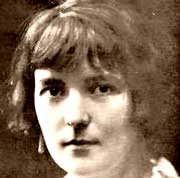Katherine Mansfield
New Zealand's most famous writer(October 14, 1888–January 9, 1923)
Katherine Mansfield was born inWellington, New Zealand, into a middle-class colonial family. Her father, Harold Beauchamp, was a banker and mother, Annie Burnell Dyer, a genteel. She lived for six years in the rural village of Karori. Mansfield has later told that "I imagine I was always writing. Twaddle it was, too. But better far write twaddle or anything, anything, that nothing at all." At the age of nine she had her first text published. As a first step to her rebellion against her background, she withdrew toLondon in 1903 and studied at the Queen's College, where she joined the staff of theCollege Magazine. Back inNew Zealand in 1906, she then took up music, and had affairs with both men and women. Her father denied her the opportunity to become a professional cello player - she was accomplished violoncellist. In 1908 she studied at Wellington Techical College typing and bookkeeping. Her lifelong friend Ida Baker (L.M., Leslie Moore in her diary and correspondence) persuadedMansfield's father to allow Katherine to move back to England, with an allowance of £100 a year. There she devoted herself to writing. Mansfield never visited New Zealand again.
After an unhappy marriage in 1909 with George Brown, whom she left a few days after weddings,Mansfield toured for a while as an extra in opera. During her stay in German she wrote satirical sketches of German characters, which were published in 1911 under the titleIn a German Pension. Earlier its stories had appeared in The New Age. On her return to London in 1910, Mansfield became ill with an untreated sexually transmitted disease, a condition which contributed to her weak health for the rest of her life. She attended literary parties without much enthusiasm: "Pretty rooms and pretty people, pretty coffee, and cigarettes out of a silver tankard... I was wretched."
In 1911Mansfield met John Middleton Murry, a Socialist and former literature critic, who was a tenant on her flat. Mansfield co-edited and contributed to a series of journals. Until 1914 she published stories inRhythm and the Blue Review. During the war she traveled restlessly between England and France. In 1915 she met her brother "Chummie". When he died in World War I, Mansfield focused her writing onNew Zealand and her family.Prelude (1916), one of her most famous stories, was written during this period. In 1918Mansfield divorced from her first husband and married John Murry. In the same year she was found to have tuberculosis.
In her last yearsMansfield lived much of her time in southernFrance and in Switzerland, seeking relief from tuberculosis. As a part of her treatment in 1922 at an institute, Mansfield had to spend a few hours every day on a platform suspended over a cow manger. She breathed odors emanating from below but the treatment did no good. Without the company of her literary friends, family, or her husband, she wrote much about her own roots and her childhood.Mansfield died of a pulmonary hemorrhage on January 9, 1923, in Gurdjieff Institute, nearFontainebleau, France. Her last words were: "I love the rain. I want the feeling of it on my face."
Mansfield's family memoirs were collected in
Bliss (1920), which secured her reputation as a writer. In the next two years she did her best work, achieving the height in the
Garden Party(1922), which she wrote during the final stages of her illness. Only three volumes ofMansfield's stories were published during her lifetime.
Mansfield was greatly influenced by
Anton Chekhov, sharing his warm humanity and attention to small details of human behavior. Her influence on the development of the short story as a form of literature was also notable. Among her literary friends wereAldous Huxley, Virginia Woolf, who considered her over praised, and D.H. Lawrence, who later turned against Murry and her. Mansfield's journal, letters, and scrapbook were edited by her husband.
Taken from:
http://www.malaspina.org/home.asp?topic=./search/details&lastpage=./search/results&ID=291